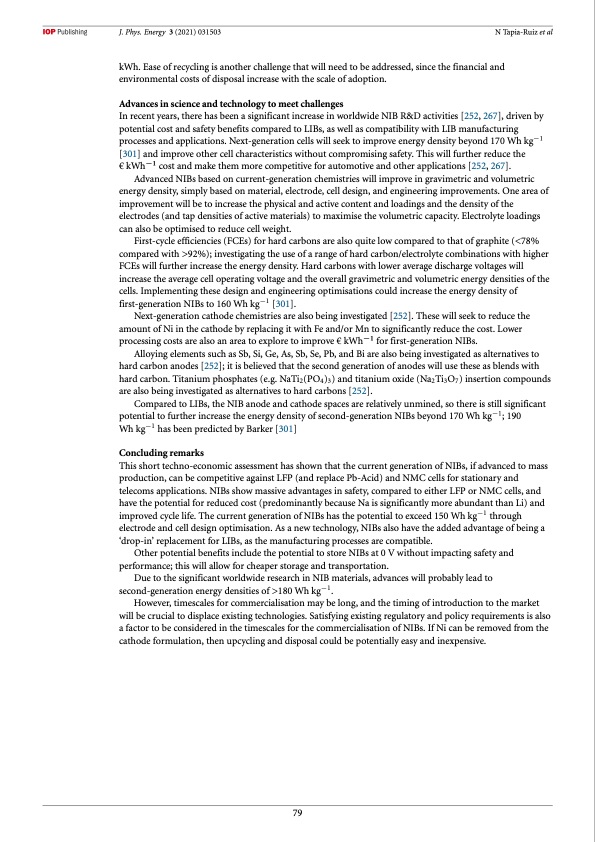
PDF Publication Title:
Text from PDF Page: 080
J. Phys. Energy 3 (2021) 031503 N Tapia-Ruiz et al kWh. Ease of recycling is another challenge that will need to be addressed, since the financial and environmental costs of disposal increase with the scale of adoption. Advances in science and technology to meet challenges In recent years, there has been a significant increase in worldwide NIB R&D activities [252, 267], driven by potential cost and safety benefits compared to LIBs, as well as compatibility with LIB manufacturing processes and applications. Next-generation cells will seek to improve energy density beyond 170 Wh kg−1 [301] and improve other cell characteristics without compromising safety. This will further reduce the € kWh−1 cost and make them more competitive for automotive and other applications [252, 267]. Advanced NIBs based on current-generation chemistries will improve in gravimetric and volumetric energy density, simply based on material, electrode, cell design, and engineering improvements. One area of improvement will be to increase the physical and active content and loadings and the density of the electrodes (and tap densities of active materials) to maximise the volumetric capacity. Electrolyte loadings can also be optimised to reduce cell weight. First-cycle efficiencies (FCEs) for hard carbons are also quite low compared to that of graphite (<78% compared with >92%); investigating the use of a range of hard carbon/electrolyte combinations with higher FCEs will further increase the energy density. Hard carbons with lower average discharge voltages will increase the average cell operating voltage and the overall gravimetric and volumetric energy densities of the cells. Implementing these design and engineering optimisations could increase the energy density of first-generation NIBs to 160 Wh kg−1 [301]. Next-generation cathode chemistries are also being investigated [252]. These will seek to reduce the amount of Ni in the cathode by replacing it with Fe and/or Mn to significantly reduce the cost. Lower processing costs are also an area to explore to improve € kWh−1 for first-generation NIBs. Alloying elements such as Sb, Si, Ge, As, Sb, Se, Pb, and Bi are also being investigated as alternatives to hard carbon anodes [252]; it is believed that the second generation of anodes will use these as blends with hard carbon. Titanium phosphates (e.g. NaTi2(PO4)3) and titanium oxide (Na2Ti3O7) insertion compounds are also being investigated as alternatives to hard carbons [252]. Compared to LIBs, the NIB anode and cathode spaces are relatively unmined, so there is still significant potential to further increase the energy density of second-generation NIBs beyond 170 Wh kg−1; 190 Wh kg−1 has been predicted by Barker [301] Concluding remarks This short techno-economic assessment has shown that the current generation of NIBs, if advanced to mass production, can be competitive against LFP (and replace Pb-Acid) and NMC cells for stationary and telecoms applications. NIBs show massive advantages in safety, compared to either LFP or NMC cells, and have the potential for reduced cost (predominantly because Na is significantly more abundant than Li) and improved cycle life. The current generation of NIBs has the potential to exceed 150 Wh kg−1 through electrode and cell design optimisation. As a new technology, NIBs also have the added advantage of being a ‘drop-in’ replacement for LIBs, as the manufacturing processes are compatible. Other potential benefits include the potential to store NIBs at 0 V without impacting safety and performance; this will allow for cheaper storage and transportation. Due to the significant worldwide research in NIB materials, advances will probably lead to second-generation energy densities of >180 Wh kg−1. However, timescales for commercialisation may be long, and the timing of introduction to the market will be crucial to displace existing technologies. Satisfying existing regulatory and policy requirements is also a factor to be considered in the timescales for the commercialisation of NIBs. If Ni can be removed from the cathode formulation, then upcycling and disposal could be potentially easy and inexpensive. 79PDF Image | 2021 roadmap for sodium-ion batteries

PDF Search Title:
2021 roadmap for sodium-ion batteriesOriginal File Name Searched:
roadmap-sodium-ion-batteries_031503.pdfDIY PDF Search: Google It | Yahoo | Bing
Salgenx Redox Flow Battery Technology: Salt water flow battery technology with low cost and great energy density that can be used for power storage and thermal storage. Let us de-risk your production using our license. Our aqueous flow battery is less cost than Tesla Megapack and available faster. Redox flow battery. No membrane needed like with Vanadium, or Bromine. Salgenx flow battery
| CONTACT TEL: 608-238-6001 Email: greg@salgenx.com | RSS | AMP |